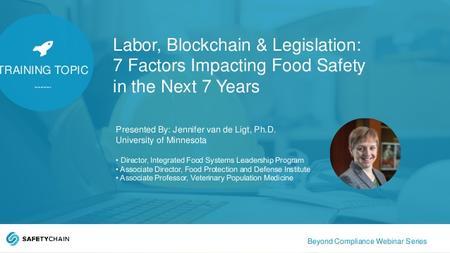September 30, 2019
Labor, Blockchain & Legislation: 7 Factors Impacting Food Safety in the Next 7 Years
During an educational webinar hosted by SafetyChain Software, Dr. Jennifer van de Ligt, the University of Minnesota’s IFSL program director, explored seven factors that are shaping food safety both now and in the future.
As context for these driving factors, Dr. van de Ligt discussed the importance of keeping in mind what food safety is and the reality of food safety today. Food safety encompasses food system reliability, including the overarching goals and practices required for mitigating exposure to natural hazards, errors, and failures.
Although food safety principles and regulatory oversight are globally recognized with many actions taken to make our food safer every day, the reality is that food safety incidents continue to a public health issue as evidenced by the staggering number of foodborne illnesses around the world. According to the WHO estimates of foodborne Illnesses in 2015, global foodborne illnesses amounted to a staggering 600 million cases, with 420,000 deaths in one year alone.
In addition, the way food is produced, manufactured, and distributed is changing rapidly as it adapts to global pressures. In order to help drive down food borne illnesses and elevate food safety across this rapidly changing global food system, Dr. van de Ligt discusses 7 key factors impacting food safety in 2020 and beyond.
7 Key Factors Impacting Food Safety
In the webinar, van de Ligt explores each of the following factors in greater detail and shares thoughts on what the industry needs to do to overcome these challenges.
1. Environment
Extreme weather events and global warming are having a large impact on crop yields and water availability which exacerbates the challenges the industry faces in meeting the needs of a growing population, which is expected to balloon from 7 billion people today to 10 billion in 2050. These environmental challenges also contribute to increasing livestock and plant disease which can impact food safety. Understanding the impact and coming up with better alternatives and plans to manage our environmental changes moving forward will be key to meeting the challenges that lie ahead.
2. Technology
Biotechnology, digitalization of records, understanding microbiomes, blockchain technology, and IoT (Internet of Things) provide a critical landscape to support better food safety outcomes. These fields are facilitating improved discovery of techniques to combat and control pathogens, along with mechanisms to support faster traceability and communications to consumers.
3. Logistics
Embracing the digitalization of food supply systems and the use of traceability solutions will support more robust just-in-time delivery from farm to fork while improving safety of products and mitigating waste throughout the supply chain. This will in turn help the industry better meet the food security concerns of the growing population without the need to vastly increase production.
4. Consumers
Consumers have an enormous impact on food safety. The industry must work to address the growing preference of meat in developing countries, the challenges in managing cold chain distribution to remote areas, and the inordinate amount of food waste by richer countries, along with the growing popularity of raw and unprocessed foods for consumption by both humans and animals alike. These preferences require better food safety education and food handling to avert foodborne illnesses.
5. Labor
Not often highlighted in the context of food safety, though important, labor availability is at all time low, especially in the US. And yet, 28% of the global population is employed directly or indirectly by agriculture. The impact of this labor shortage means the food industry is relying on temporary and day-labor, which puts at risk the training and monitoring required for proper execution of food safety practices. To alleviate some labor issues, automation is used and this also changes and often introduces new food safety risks.
6. Policy
In the food safety arena, policy is incredibly important. Policy on immigration impacts the food industry’s access to foreign workers to meet labor shortages. Regulations such as the US’s Food Safety Modernization Act (FSMA) and similar regulations being implemented in China, Canada, and Australia are key to helping us move from a reactive to a proactive food safety system. Policies surrounding tariffs impact food safety as lesser-known suppliers in different countries are sourced to drive down costs and meet demands. New innovative uses of food by-products also create shifts in food safety risks.
7. Media
The media has an enormous influence on food safety as well, and in essence plays a key role in shaping the six other factors. Misleading headlines or the quick distribution of erroneous information can have an enormous impact on food brands and can fuel consumer confusion. As media influences perceptions and actions, it can both help and hinder food safety efforts depending on how the news is deciphered and acted upon at the government, industry, and individual consumer level.
Food Safety in Coming Years
Shifting global pressures and their interrelationships will drive change in food safety practices. As Dr. van de Ligt emphasizes, “We need to begin sowing the seeds of interdisciplinary food safety innovation to assure we are ready.”
To get us there, key leadership skills are required. Our leaders will need a broader food system competency and approach; knowledge and understanding of interdependencies; critical and strategic thinking to help problem solve across disciplines; and the critical skills of effective communication and negotiation to ensure that larger goals and needs are being met of our food system.
Dr. van de Ligt is director of the Integrated Food Systems Leadership (IFSL) Program and associate director of the Food Protection and Defense Institute at the University of Minnesota.
Access webinar recording and slides here.
For more information about the University of Minnesota’s IFSL Program, visit https://ifsl.umn.edu. IFSL Program applications are accepted on a rolling basis for the next cohort. Download a program brochure or schedule a consultation call for more information.
